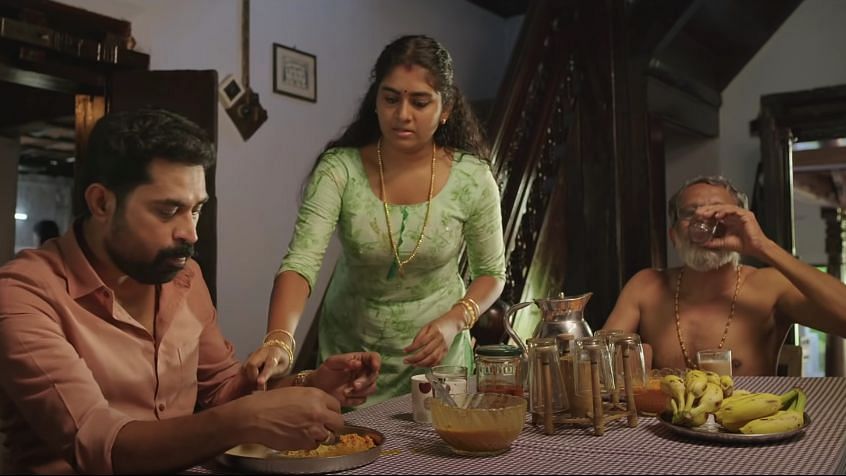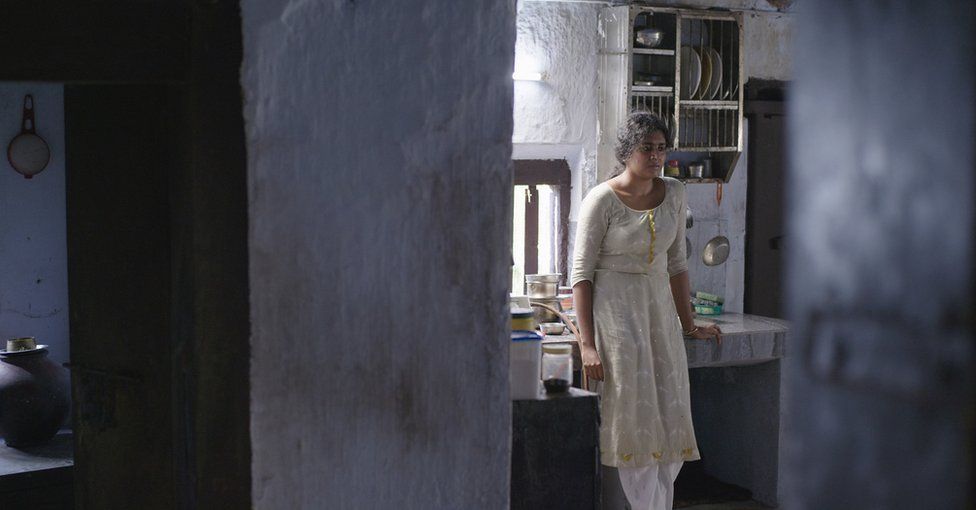Jeo Baby’s January 2021 Malayalam feature The Great Indian Kitchen won the Best Film and Best Original Screenplay titles at the 51st Kerala State Film Awards announced recently. Set against the backdrop of a dominant caste, feudal family in Kerala, the film follows the domestic experiences of a young bride (played by Nimisha Sajayan) who marries into the household.
The Great Indian Kitchen discusses the politics of gender and critiques the assignment of gender roles to women within the domestic space, especially the kitchen. It chronicles the labour attached to housework which is daunting and seldom shared by the male stakeholders in families.
If we peruse the landscape of Malayalam cinema in the past decade, it can be observed that the gender lens continues to be skewed in favour of the established, male dominant morality. Very few films manage to subvert this gaze of gender and The Great Indian Kitchen is among them.

If one were to compare the representation of women exclusively within the domestic space, perhaps Akku Akbar’s 2008 film Veruthe Oru Bharya is the immediate predecessor of The Great Indian Kitchen.
The film portrayed the woes of Bindu, a wife and mother (played by Gopika) struggling with domestic chores on one hand and a controlling husband on the other. The two films, a decade and two years apart, are fundamentally set in the same thematic universe.
Though the former appears to extend critical empathy towards the exhausted minds and bodies of women bludgeoned with domestic work, it ends up patronising them with its benevolent sexism. The latter uses the very same patronisation to hold our collective conscience accountable for the convenient sidelining of women into cleaning, cooking and child rearing within households.

Women in the kitchen
The kitchen has always been a demarcated female space where women perform gender through cooking, cleaning and serving. Even if we look at the advertisements around cooking, kitchen appliances or even the architecture of a kitchen itself, they place at their core the functional needs of women. Therefore, within the domestic setting, while most other spaces are co-occupied by all genders, the kitchen is almost exclusively assigned to women.
The protagonist Bindu in Veruthe Oru Bharya is an extension of this. She wakes up before everyone else does, so that they have all their culinary and care needs met on time. Her husband is a man who believes he is entitled to her labour, and maintains that he is the rightful gatekeeper of her time, body, wardrobe and life. He waits for her to bring him his tea in the morning, while he reads his newspaper. In a scene, he yells out to her holding his shirt in hand, for her to come and wear it on him for office.
Bindu is restricted from visiting her own parental home, or maintaining cordial relationships with her family. She seldom steps outside the house and the film clearly establishes what space she occupies within her marriage and her domestic setting – that of a giver and doer.
The film constantly comments on the amount of physical labour exerted by a woman in the house, yet eventually chooses to put the onus on the woman herself by glorifying the emotional disillusionment of the husband once she leaves him and their teenaged daughter. It dumps the responsibility of child rearing and constant accommodation on the woman by citing the fragility of a grown, employed man who is left ‘without anchor’ in his own house. Bindu finally comes back and embraces her life in return for her husband’s occasional attention and presence.
If one were to pick up a scalpel and get to the root of the messaging of this film, it is quite simple – women suffer in the domestic space and men must ‘help’, but it is unbecoming of women, especially mothers to leave a marriage or domestic setting that invisibilises their identity and exploits their labour.
The film was widely accepted by the family audience in the State, and most viewers sympathised with the predicament of women in households. But sympathy that is unquestioning of status quo is quite useless to the oppressed.
The fact that a film which criticises the positioning of women in the domestic space gained so much traction amidst a pandemic is quite telling of the slow shift in conscience among viewers, not only with respect to cinematic expression but also gender politics. The Great Indian Kitchen also draws strong analogies between women, religion, caste and class. It tries to comment on the marginalisation of female labour and identities within these power structures which are produced and overseen by the male conscience
Twelve years down the line, we have The Great Indian Kitchen which also focuses on women in the domestic setting, especially the kitchen and its surroundings. What makes Jeo Baby’s iteration of women in the kitchen much more radical and resonant is its repetition of activities.
Nimisha Sajayan’s unnamed character is seen to repeat activities like cooking, cleaning, serving, washing and cooking again. The visual language of the film was critiqued by a few as monotonous, and the film harbours the reply to that comment in its structuring itself – women live monotonous, daunting lives in households. There is no new ground to be broken while making dosa or prepping for dinner. Cleaning every family member’s leftovers and segregating kitchen waste is uneventful, downright maddening even, but they have no choice.
Also read: Analysing Body, Autonomy & Gendered Spaces In The Great Indian Kitchen

The responses of the men to this assignment of gender roles are unsurprisingly the same in both Veruthe Oru Bharya and The Great Indian Kitchen. The husband in The Great Indian Kitchen is offended when his wife conveys her sexual needs. He expects her to serve and put everything together while he enjoys his morning yoga and leisure. The same goes for the father in law, who speaks to her about the nostalgic taste of food prepared by hand, with minimal use of mixer grinders and gas stoves.
What places both films poles apart is that while the former is rooted in patriarchy’s benevolent gaze of women and the magnanimity of men in occasionally ‘helping’ out, the later is furious about the escalating vulgarities of the family structure, where women have no agency to negotiate power or retain any kind of control over the demand for their labour to suit the requirements of everyone else.
Female assertion on screen: Then and now
The change in narrative in The Great Indian Kitchen from the extremely problematic Veruthe Oru Bharya is positively reinforcing. The film was initially rejected by most streaming giants, and was launched by Nee Stream, an OTT platform that is now famous for green signaling this film.
It became an undeniable cinematic presence through word of mouth and was then acquired by Amazon Prime. The fact that a film which criticises the positioning of women in the domestic space gained so much traction amidst a pandemic is quite telling of the slow shift in conscience among viewers, not only with respect to cinematic expression but also gender politics.
The Great Indian Kitchen also draws strong analogies between women, religion, caste and class. It tries to comment on the marginalisation of female labour and identities within these power structures which are produced and overseen by the male conscience.
In the past decade, we have not seen a woman on screen who is driven so insane by cooking, cleaning and being taken for granted at home that she decides to walk out of the structure that enables it. The significance of The Great Indian Kitchen lies in its radical sense of empathy, and the resounding message that marriage, family, religion or any institution cannot thrive on the exhaustion and erasure of female agency and dignity – a non-negotiable tenet of social, personal and political collaboration that a supposedly ‘female oriented’ film like Veruthe Oru Bharya completely missed
The labour performed by a woman in the kitchen does not beget her any economic incentive and is thus rendered invisible in the economy. Earlier this year, the Left Democratic Front (LDF) in Kerala promised pension for housewives in their election manifesto.
The incentivisation of women’s labour within the household by the State is undoubtedly a step forward in accounting for it. But in the long run, incentivising women’s domestic labour is also perhaps assigning women the sole custodianship of the household and reinforcing their primary identity as one tied to their domestic responsibilities in a family.

The resolution of women’s oppression within the domestic space does not stem from the monetisation of their labour. It is of course at this stage, better than slogging without any incentive. But while we try to provide women that kind of social security, we must also understand that the solution to this is the dismantling of gender roles within the domestic space.
Perhaps the best outcome of The Great Indian Kitchen is the mainstreaming of discussions on the construction of female personhood within families. It sure aggravated quite a large population of viewers, but it also mobilised the narratives of many women who responded that their lived experiences were recognised in the film.

In the past decade, we have not seen a woman on screen who is driven so insane by cooking, cleaning and being taken for granted at home that she decides to walk out of the structure that enables it. Most women including Bindu have been deeply affected by it, but we did not sanction our heroines to break out of sacrosanct spaces like marriage and family. We managed to rein them in by slightly stretching their boundaries and occasionally threatening them with the social tribulations of ‘not falling in line‘.
The significance of The Great Indian Kitchen lies in its radical sense of empathy, and the resounding message that marriage, family, religion or any institution cannot thrive on the exhaustion and erasure of female agency and dignity – a non-negotiable tenet of social, personal and political collaboration that a supposedly ‘female oriented’ film like Veruthe Oru Bharya completely missed.
Veteran actor Suhasini, the jury Chairperson of the Awards said that the decision to choose the film was unanimous. It is now official that the Best Film released in the State in the last year is a film that hails a woman who is not ready to submit in return for the occasional crumbs of validation that patriarchy baits her with.
Many congratulations to the team on their big Kerala State Film Awards win.
Also read: Film Review: The Great Indian Kitchen – Serving Patriarchy, Piping Hot!
About the author(s)
Sukanya is a lawyer-turned-journalist with experience in writing, editing, development communication, and advertising. She holds a graduation in law, a post-graduation in philosophy, and a post-graduate diploma in print journalism. She is also a published poet and was awarded the All India Poetry Prize in 2015. Her journalistic work is deeply focused on gender and intersectionalities, and they appear in Feminism In India, True Copy Think, and The News Minute.




